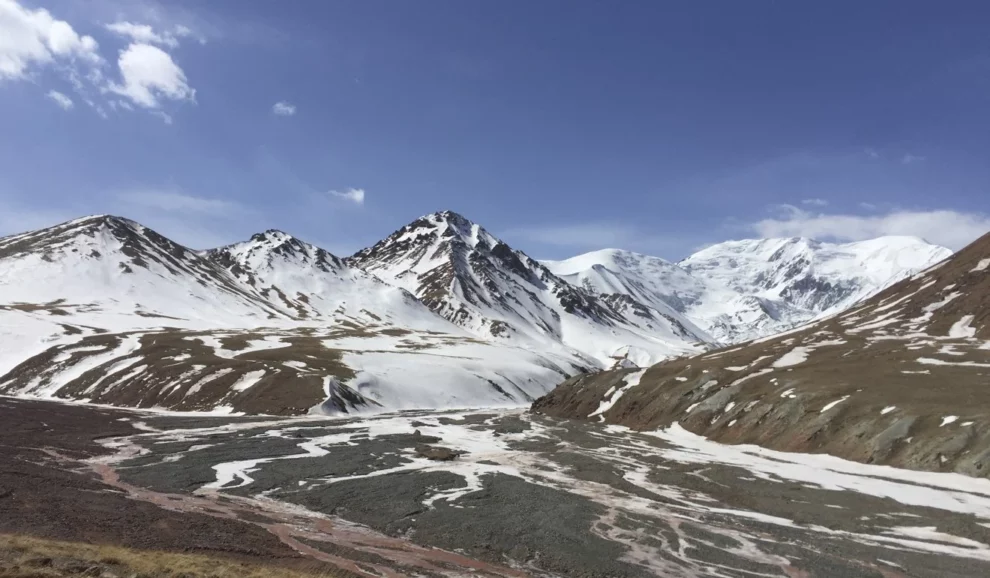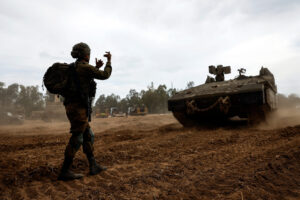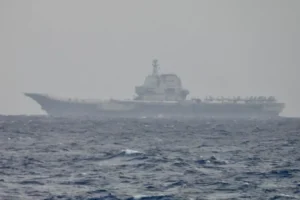The table is set for the Gorno-Badakhshan Autonomous Oblast to remain a geopolitical hotspot, as important as it is distant.
Gorno-Badakhshan Autonomous Oblast (GBAO), eastern Tajikistan, is many things. It is the home to the Pamir Mountains, also called “the roof of the world,” whose sharp mountain ranges and deep valleys resemble a lunar landscape. A far-flung frontier, situated in a troubled neighborhood, next to Taliban-controlled Afghanistan and China’s Xinjiang Uyghur Autonomous Region, GBAO is a geopolitical treasure tethered to exterior interests: the authoritarian central Tajik government in Dushanbe, Chinese economic and military interests, and Russia, which historically frames the Pamirs as a part of its geopolitical backyard. The region’s inhabitants, the Pamiris, however, are seldom counseled.
In August 2021, desperation arrived in Ruzvat, a river community high up in the Pamir Mountains, in Gorno-Badakhshan Autonomous Oblast (GBAO), in eastern Tajikistan. The Panj River embodies the floating border between Tajikistan and northeastern Afghanistan, and the Taliban movement’s seizure of political power shook the ground on both sides of the river.
The Taliban’s successful power grab had swept through an Afghanistan militarily weakened by the abrupt American withdrawal after a 20-year presence in the country. The geopolitical map of Central Asia was, yet again, redrawn.
“The border closed, and along with that our livelihood was cut off,” Gulshan, a market vendor in Ruzvat, told me.
In GBAO, people have learned to decipher the geopolitical gales sweeping over the Pamir Mountains. The Panj River embodied the frontier during the Soviet-Afghan War and was a stronghold for the Afghan Northern Alliance, which militarily opposed the first Taliban government in Kabul in the later 1990s. Since the independence of Tajikistan, in the wake of the fall of the Soviet Union in 1991, the Pamirs have remained a stronghold for various movements – and above all, an identity – that challenge the hegemonic Tajik nationalism bred by authoritarian President Emomali Rahmon in faraway Dushanbe, Tajikistan’s capital.
People have also learned how to stave off hunger. The sound of the river is ever-present from the threshold to Gulshan’s one-story-house. The view is hypnotic. A pallid winter sun looms just above the sharp mountain tops. On the Afghan riverbank, washed rugs dry in the sun next to tiny lots plowed by cows. It is an unforgiving environment adorned by the Taliban movement’s white flag.
“We often wave to the Taliban soldiers who patrol the river,” Gulshan told me. “They swing their Kalashnikovs over their shoulders and smile and wave back. They ride the jeeps that used to belong to the U.N. – the Taliban have just painted over the logo.”
Nowadays, waving is the only contact they have with their Afghan neighbors. Since the Taliban takeover, the border between the two countries remains closed, as well as the international market in Darvoz, next to a bridge border crossing. The source of income for river communities like Ruzvat is gone and has been replaced with nothing.
“We used to have our regular stand at the market in Darvoz, and we relied on trading and selling goods to Afghans,” Gulshan explained while walking up the slope to the Pamir Highway, a near-mythical stretch of cracked but paved road built by Soviet engineers in the 1930s upon historical trading routes entwined with the ancient Silk Road.
Along with her neighbor, friend, and colleague Nasreen, they now wave to passers-by in desperate hope that they will hit the brakes to purchase seasonal Bukhara pears, daily fresh tomatoes, or newly reaped onions displayed in buckets, upon cardboard boxes, or dangling from tree branches.
Their survival – like that of most residents of the border communities along the Panj River since the Afghan border closed – depends entirely on personal ingenuity.
In late November 2021, things got even worse in the Pamirs. A 29-year-old civilian, Gulbiddin Ziyobekov, was killed by Tajik police in Tavdem, a village south of Khorog (GBAO’s capital and largest city, with a population of around 30,000). The killing, described by witnesses as an assassination, sparked uprisings directed at the central government and Rahmon.
The following year, 2022, has been described as one of the worst years for human rights in Tajikistan since the end of the civil war in 1997, especially in GBAO. In May 2022, over a thousand Pamiris took to the streets of Khorog and Rushan, a strategic town along Pamir Highway, demanding justice for the killing of Ziyobekov and a governmental response to inflated commodity prices.
Dushanbe responded – with live ammunition, tear gas, mass arrests, torture, killings, and a four-month-long internet shutdown.
Local accounts estimate that more than 40 people lost their lives because of the uprisings in Khorog and Rushan; among them influential local leader Mamadboqir Mamadboqirov, who was slain in the streets of Khorog, having been on the central government’s hitlist ever since the mid-1990s. “Colonel Boqir,” as he was known, was a military commander for the Tajik Pamiri military forces and an outspoken critic of Rahmon. Hundreds of people have been arrested and tortured; private businesses have been nationalized and properties and financial capital seized by authorities.
In a symbolic gesture of total colonization, the Pamiri Ismaili flag was removed from a hilltop near Khorog.
With Mamadboqirov’s killing, there are few, if any, local Pamiri leaders left. Over the last three decades, the social structure of GBAO has been uprooted. The central Tajik government’s latest crackdown occurred while the rest of the global community has been focused on combatting inflation and addressing security issues in the wake of the Ukraine war. Rahmon and his peers have displayed their utter willingness and determination to erase whatever local autonomy GBAO had been granted after the civil war.
In GBAO, there is simply too much to gain in the eyes of exterior forces: the Pamir Mountains are a geopolitical asset not only for the central Tajik government in Dushanbe, but to Chinese economic and military interests. The region is an integral part of Beijing’s Belt and Road Initiative. And Russia considers the Pamirs a corner of its geopolitical backyard.
Much is at stake in the Pamir Mountains, and GBAO has been a geopolitical treasure tethered to exterior interests ever since the British and Russian empires drew swords on the roof of the world in the 19th century. GBAO covers nearly half of modern-day Tajikistan, and yet its population is merely 250,000 of the country’s 9.5 million inhabitants. Sharp mountain ranges cover large portions of the territory, and only a fraction – 3 percent – is arable land, but the earth contains many profitable natural resources, such as gold, uranium, and water.
GBAO remains, despite its riches, plagued by poverty and the lack of a basic social infrastructure. A century ago, when the region was integrated into the Soviet Union, the Pamirs welcomed an influx of engineers and settlers. The construction of the Pamir Highway paved the way for a modernization of eastern Tajikistan and gave the Pamirs access to neighboring Kyrgyzstan in the north, Uzbekistan in the west, and Afghanistan in the south.
“People used to have a reason to stop along the road – now, there’s only traffic coming from China or Kyrgyzstan, heading straight for Dushanbe,” Nasreen lamented. “Dust is all that lingers.”
Many of the answers to Tajikistan’s current political riddles can be traced back to the civil war between 1992 and 1997, a bloody conflict that some estimates say cost more than 100,000 lives and displaced more than 1 million people. The fall of the Soviet Union opened Pandora’s box, and various interests entered the battlefield in a quest for political power. Emomali Rahmon was one of them, and eventually ended up as the leader of the winning side of the war; one that had cast off its Communist mantle and replaced it with staunch nationalism and rampant nepotism.
On the losing side stood a cluster of opposition groups under the umbrella of the United Tajik Opposition (UTO), led by the Islamic Renaissance Party, which had significant support in the Pamirs. The local government in GBAO even attempted to break free from the rest of Tajikistan and create an independent state. In the years after the 1997 peace treaty formally ended the war — and despite provisions in the peace agreement mandating space in the government for the opposition — Dushanbe routinely cracked down not only on the Islamist opposition but on local authorities in GBAO as well.
The highest price, though, has been paid by the local population, among them vendors like Gulshan and Nasreen. Desperation and despair are widespread, In 2021 more than 1.6 million Tajiks, most of them men, emigrated to Russia for work in what has become a routine flow of migrant workers. In Tajikistan countless families are dependent on remittances from abroad. In 2022, the Russian invasion of Ukraine sparked concerns that the migrant economy would crater along with the Russian economy. But instead, rates of migration to Russia continued to increase following their 2020 pandemic slump, including from Tajikistan. The war, however, generated new risks for Tajik migrants, in particular that they would be recruited or coerced into joining Russian forces on the frontlines.
“Many who make the journey to Russia are never heard from again,” said Gulshan.
The Pamir Highway has long been a route for the illicit drug trade coming out of Afghanistan, but sanctions — against the Taliban government in Afghanistan and Russia for the invasion of Ukraine — have arguably intensified the unique set of geopolitical circumstances in GBAO.
Vast portions of heroin, sourced from Afghan poppy fields, are smuggled along Tajik roads from Afghanistan into Kyrgyzstan en route to Russia and Europe. Sanctions, drought, and severe famine have led to increased desperation among Afghan farmers, which has amplified the need for alternative sources of income, paving the way for increased opium production. For unemployed Pamiris, smuggling drugs along the road to Osh, Kyrgyzstan, can be lucrative work.
“People find themselves with no other choice, desperate,” Adis, a Pamiri herder residing in Alichur, a frontier town high up in the Pamirs, closer to Xinjiang, China, and Osh than Dushanbe, tells me. “Survival in the Pamirs depends on the access of flour, gasoline, and animal fodder. For that, you need money, and when prices on everything have sky-rocketed these past years – what do you expect people to do?”
The Tajik government’s latest crackdown is part of a pattern, where Dushanbe continues to target opposition forces and local authorities by aggressive means, often under the guise of “combating terrorism.” Eastward, in Xinjiang, Chinese authorities have increased their military presence along the Tajik border, raising concerns among some in Moscow about a decreasing strategic Russian foothold on the “roof of the world.”
The latest wave of repression did not lead to broad domestic blowback in Tajikistan, but the Tajik government runs the risk of triggering a backlash with each crackdown. Dushanbe might continue to justify repression under the banner of “counterterrorism,” but that could also pop the balloon of enforced authoritarian stability.
The table is thus set for GBAO to remain a geopolitical hotspot, wedged as it is between China’s repressive regime in Xinjiang, the central Tajik government in Dushanbe and its patrons in Russia, and the troubled situation in Afghanistan. And through it all, the people of GBAO will continue to eek out a life among the peaks and valleys of the Pamir Mountains, watching as the Panj River flows by.
“We either wait for a better future, or build one ourselves,” Adis concludes. “Pamiris have always been isolated and dependent on themselves; these past years don’t change that.”
Source: The Diplomat









